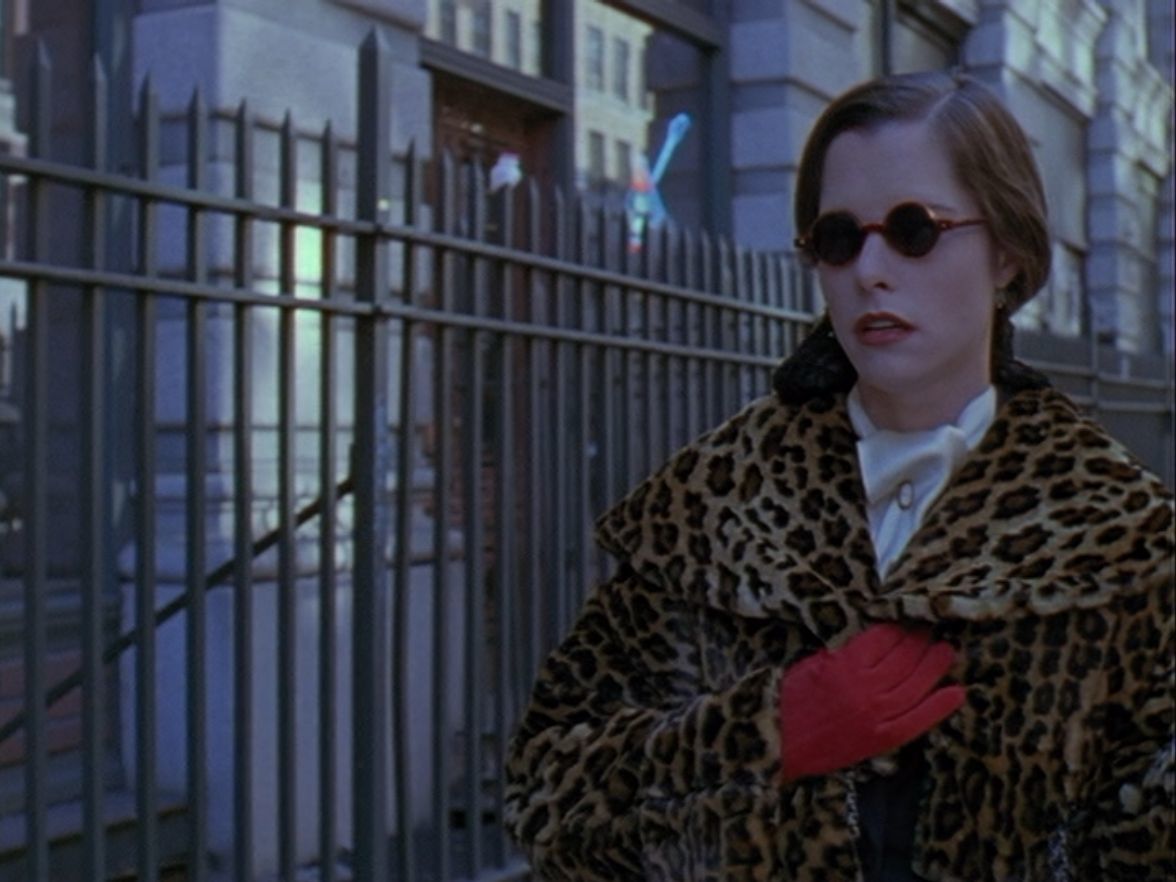Our favorite writers muse on their muses as we bring back the “My i-Con” essay series for the second year in a row. From Grimes to Grace Jones, read every heartfelt ode to personal style here.
“You don’t think I’m smart enough to work in your fucking library?“
So goes one of cinema’s best job interview scenes, in which Mary, a Chinatown club kid arrested for throwing an illegal rave in her apartment, begins her transformation into a…. librarian. “5 pesos,” she tells the undercover cop, blowing weed smoke in his face. The next morning, Mary’s godmother Judy bails her out, and Mary — with as little shame as she has cash — asks for a loan. She gets hired at Judy’s branch instead.
Party Girl came out in 1995. The librarian-by-day, club-kid-by-night setup is laughably simple: Party Girl is hired at library. Party Girl falls in love with falafel vendor. Party Girl screws him in the library, gets fired, and — after some soul-searching, a closet overhaul, and a bender — decides to ask for her job back and become a librarian full-time. Naturally, plot is only a small part of the film’s appeal. (Did the best party you’ve been to have a plot?) What makes Party Girl a classic is a dope house music soundtrack, an insane costume department, and a leading lady who makes demands for “a nice, powerful mind-altering substance, preferably something that would make my unborn children grow gills” in fire deadpan.
In 1995, when this film came out, my version of a party included Chuck-E-Cheese. I didn’t come across it until years later, in college, as my own Party Girl phase was coming to an end alongside such habits as taking naps outside the Paris metro and using the website couchsurfing.net to book travel accomodations. But I still had a closet of sequined shorts and velvet jumpsuits, tie-dyed robes and lucite platforms. And I identified with Mary, not only because of her wacky outfits — all of which I still, to this day would personally wear — but because of how they seemed to be in conflict with her ambitions. To succeed in the world of books, would Mary have to relinquish her collection of Todd Oldham mini skirts? If I was to became a professional writer, could I still say that Party Girl was my favorite movie (not in small part because of the Westwood corsets)?
Of course, if you’re willing to take clothes as seriously as Mary does, you’ll realize the corsets — and the fake-fruit hair clips, and the hats shaped like upside-down potted plants — are more like characters in this film than props. When Mary seduces Omar, the falafel vendor, it’s with a daily parade of looks. Later, when she needs to pay rent, she sells off a Gaultier suit. As Mary starts to take her job as a library clerk more seriously, her style quiets. By the final scene, Mary’s in oval-shaped glasses, a black turtleneck, and a black, boxy jacket with a brooch. It’s librarian drag only a fashion girl could dream up, so real that it’s fake. “I’m serious about graduate school!” Mary protests as a stripper hired by her friends for her surprise birthday party shimmies his shirt around her waist.
By the end, Mary proves her scholarly intentions to her godmother, and the pair — along with Mary’s friends and the stripper — end up dancing together like one happy family. Maybe throwing raves and going to graduate school aren’t mutually exclusive! It’s a lovely thought, a classic of the fun-girl-gets-serious comedy genre (see: Clueless, Legally Blonde). But it’s also an escape from reality more than a reflection of it. In 2016, when even hyper-professional women have failed to crack the glass ceiling, a rococo wardrobe and a clubbing habit can still very much exclude you from certain jobs, fairly or otherwise.
Here’s the biggest difference between today and the Party Girl era: that same habit might qualify you for other jobs. In 1995, a party girl who wanted to get serious had to become a librarian; in 2016, she just has to cash in on influencer campaigns. Party Girl was the first feature film to be released on the internet, broadcast from an office in Seattle to several hundred people over a nascent video conferencing service in 1995. Was this an omen? These days, Mary’s old neighborhood haunts — Seward Park, Lafayette Street — are still packed with girls wearing Comme des Garçons tees and patterned tights, but for the most part, these girls have a pretense for partying — DJing, modelling, acting. Our apartments are shittier and more expensive, and our fun is a means to an end: temporary mind-numbing, networking, the building of personal brands.
These days, I spend most of my time writing, and I don’t go to all that many parties. When I do, it’s sometimes hard not to see them opportunistically, in terms of the people I might meet and the pictures that might be taken. But then I think of Mary, and I snap out of it quick. It’s not the happy-ending Mary who helps me most, but the one from the beginning of the movie, who left conversations mid-sentence to dance with passersby, fell asleep on her own stairs, shoplifted from house party closets. Her talents: “Maintaining when we’re fucked up, applying makeup, partying, flirting, making stuff up,” she rattles off. “I’m a loser. Shoot me.” It’s a lesson we’d all do well to remember: Parties are best when they don’t have a plot. Go, wear a corset, and have a good time.
Related: In search of River Phoenix’s thrift store mystique
Credits
Text Alice Hines
Still from Party Girl
